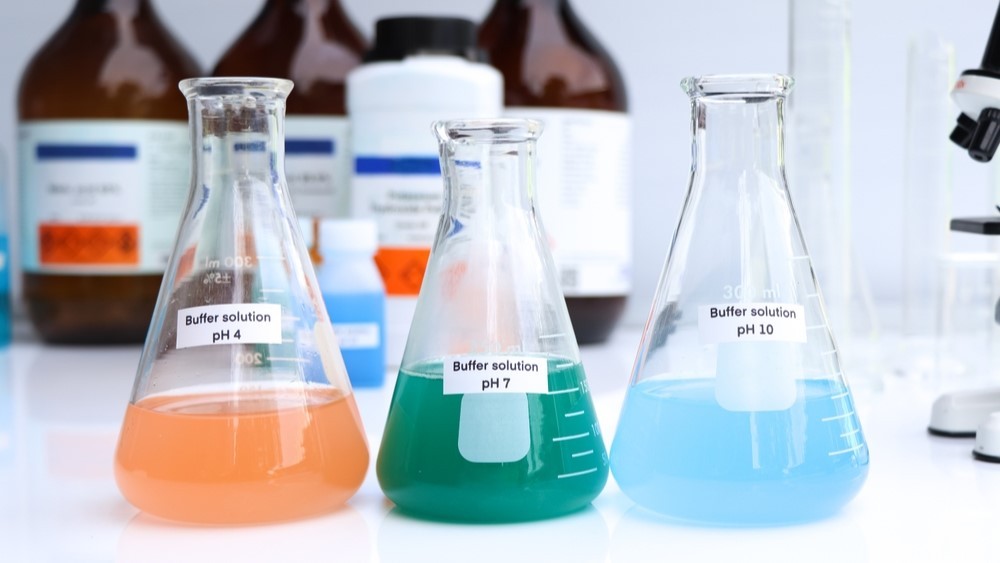A buffer solution is a solution of substances or a mixture of substances that helps in maintaining and establishing specific pH.
Buffer solution
Consider an aqueous solution that is meant to contain ‘a’ moles/liter of a weak acid HA
and ‘b’ moles/liter of its conjugate base A. But in practice, the actual concentrations of these species will be slightly different, because of dissociation equilibrium.
HA\;\rightleftharpoons H^+\;+\;A^-
The concentration can be considered as
\left[HA\right]\;=\;a\;-\;\left[H^+\right]
\left[A^-\right]\;=\;b\;+\;\left[H^+\right]
The dissociation constant is
K_a=\frac{\left[H^+\right]\left[A^-\right]}{\left[HA\right]}
pK_a=pH-\log\frac{\left[A^-\right]}{\left[HA\right]}
Substituting the above values in this equation,
pK_a=pH\;-\;\log\;\left[\frac{b\;+\left[H^+\right]}{a\;-\;\left[H^+\right]}\right]
practically we can consider that IH I is much smaller as compared to ‘a’ or
pK_a=pH\;-\;\log\;\left(\frac ba\right) 1.1
This is the Henderson-Hasselbalch equation which relates the pH of the solution containing comparable and appreciable Concentration Of a conjugate acid-base pair to the ratio Of their concentrations.
This equation has application in describing the solubility of acids and bases, and the stability of organic compounds. measurement Of dissociation constant, and transport across biological membranes.
Such solutions are called Buffer solutions, which resist a change in pH upon the addition of a small amount of acid or base.
The equation (1.1) can also be written as
pH=pK_a\;+\;\log\;\frac{\left[Conjugate\;base\right]}{\left[Conjugate\;acid\right]}
If we know two quantities we can easily find the third value, The principle function of a buffer is to minimize changes in pH and hence, it is of practical importance to determine how this buffer capacity depends upon the buffer solution properties. To measure the buffering capacity we use the buffer index \beta.
If ‘b’ is the concentration of a strong base added to a solution containing the total concentration ‘C’ of a weak acid, the buffer index is defined by
\beta\;=\;\frac{db}{dpH}
The higher the value of 5, the greater the buffer capacity of the solution.
\beta has a maximum value when pH = pKa of buffering acid. But for practical purposes, a pH value of pKa ± 1 gives acceptable buffering capacity.
Hence, the choice Of buffer solution Will depend upon the pH desired for the solution.
The buffering mechanism for a mixture of weak acid and salt is governed by the following:
pH\;=\;Cons\tan t\;+\;\log\;\frac{\left[A^-\right]}{\left[HA\right]}
If the solution is diluted, the ratio remains constant and so the pH Of the solution does not change.
If a small amount of strong acid is added, it will combine with [A-] to produce HA Thus, the change in the ratio [A-]/ [HA] is small, and hence the change in pH is small.
If a small amount of strong base is added, will combine with part of HA to form the equivalent amount Of Thus, again the Change in ratio Will be small,
Some of The Common buffers in the intermediate range are acetate, phosphate, carbonate, borate, citrate, etc.
Buffer solutions are used in various quantitative assays. They are used in the proper progress Of reaction by controlling pH, in the precipitation processes, in complex formation reactions, and also in the detection of endpoints in some titrations.
Make sure you also check our other amazing Article on: Law of Mass Action Derivation
